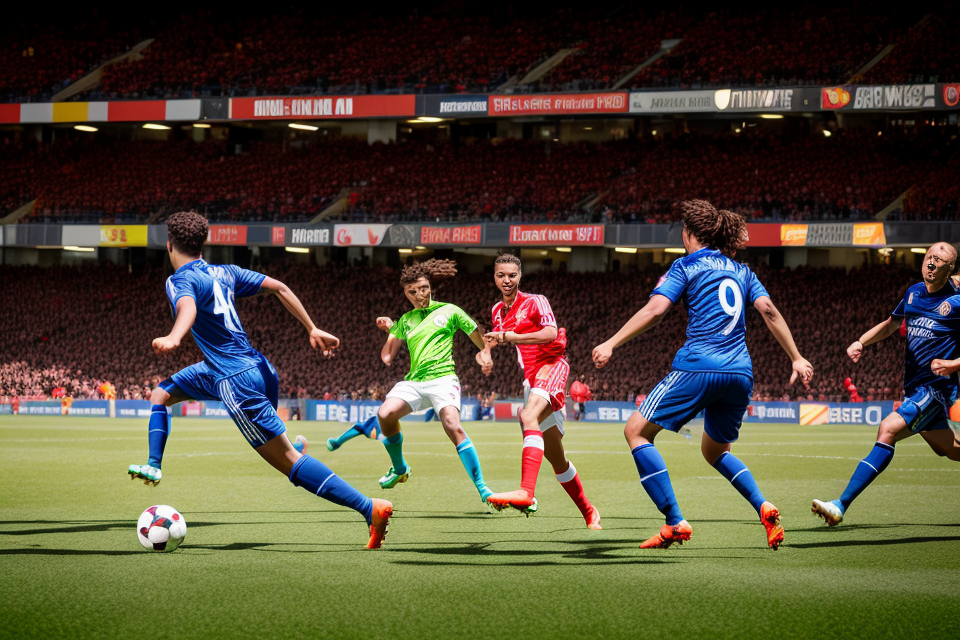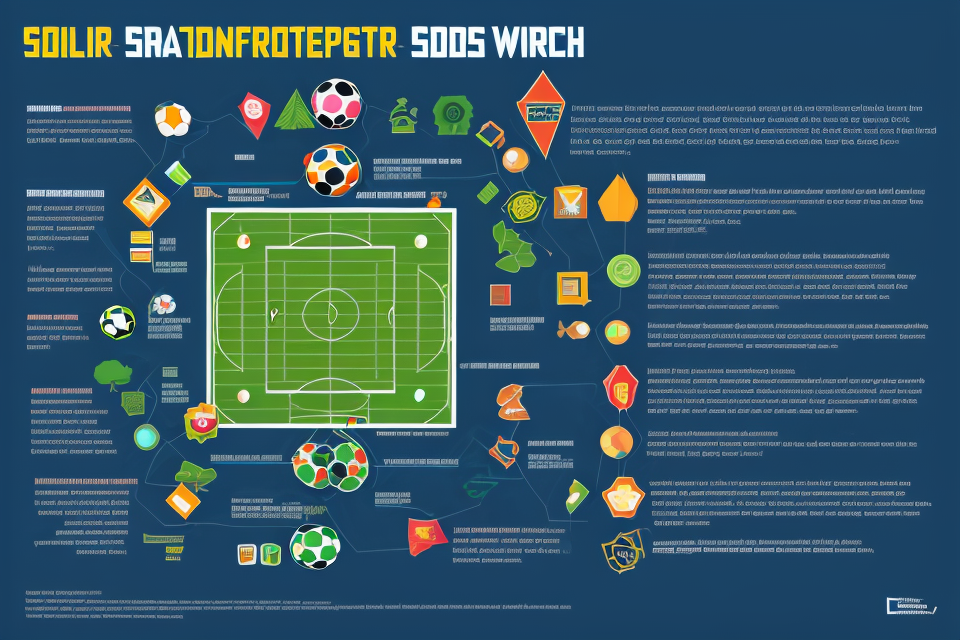Football is a game of strategy, and it is often said that the team that has the best strategy wins the game. But why is strategy so crucial in football? The answer lies in the complexity of the game. Football is a game that involves many variables, such as the players, the ball, the field, and the opposition. To be successful, a team must be able to anticipate and respond to these variables in a way that maximizes their chances of scoring and minimizes the opposition’s chances. A good strategy can help a team do just that, by providing a clear plan of action that can be executed on the field. In this article, we will explore why strategy is so important in football and how it can help a team win games.
Strategy is crucial in football because it helps teams to effectively plan and execute their actions on the field. A well-designed strategy can help a team to control the flow of the game, create scoring opportunities, and prevent the opposition from scoring. It can also help to manage the physical and mental demands of the game, by allowing players to conserve energy and make tactical changes as needed. Additionally, a good strategy can help to maximize the strengths of the team and minimize their weaknesses, giving them a better chance of winning.
The Importance of Strategy in Football
Understanding the Game
Knowing the Rules
In football, strategy is crucial as it involves making tactical decisions based on the rules of the game. It is essential to have a thorough understanding of the rules to make effective strategic decisions. Some of the key rules that impact strategy in football include:
Offside Trap
The offside trap is a tactic used by defenders to catch the attacking team off guard. It involves the defenders pushing up the field to try and catch the attackers offside. If the attackers are caught offside, the ball is turned over to the defending team.
Offensive and Defensive Positions
Each position on the field has a specific role in the game. The offensive positions include the forwards, midfielders, and attacking midfielders, while the defensive positions include the defense, defensive midfielders, and goalkeeper. Understanding the roles of each position is crucial in developing effective strategies.
Free Kicks and Corner Kicks
Free kicks and corner kicks are important set pieces in football. They provide opportunities for the attacking team to score and for the defending team to defend. Understanding how to defend against free kicks and corner kicks is essential in developing effective strategies.
Knowing the Opponent
In addition to understanding the rules of the game, it is also important to know the opponent. This includes scouting the opponent’s strengths and weaknesses and analyzing their playstyle. Knowing the opponent’s playstyle allows the team to develop effective strategies to counter their tactics.
Overall, understanding the rules of the game and knowing the opponent are crucial in developing effective strategies in football.
Developing a Game Plan
Formulating a Strategy
In football, a game plan is a crucial aspect of the strategy that a team adopts to achieve success on the field. It involves devising a comprehensive plan that covers all aspects of the game, including offensive and defensive strategies. The following are some of the key elements of formulating a strategy in football:
Offensive Strategy
Build-up Play:
A build-up play is a strategy that involves a team slowly moving the ball up the field, passing it from one player to another, until they reach the opposition’s penalty area. This strategy is designed to create scoring opportunities by moving the ball through midfield and into the final third of the pitch.
Counter-attacks:
Counter-attacks are a crucial part of any offensive strategy in football. They involve quickly transitioning from defense to attack, exploiting the opposition’s weaknesses and catching them off guard. A well-executed counter-attack can catch the opposition off balance and create scoring opportunities.
Set-pieces:
Set-pieces are another important part of an offensive strategy in football. These include free-kicks, corners, and throw-ins, and can be used to create scoring opportunities or disrupt the opposition’s defense.
Defensive Strategy
Defensive Formation:
The defensive formation is a critical aspect of a team’s defensive strategy in football. It involves positioning players in a way that minimizes the risk of conceding goals while also allowing the team to maintain possession of the ball.
Tackling:
Tackling is an essential part of any defensive strategy in football. It involves stopping the opposition from moving the ball forward by tackling them when they have possession. Good tackling technique is essential to prevent the opposition from gaining momentum and creating scoring opportunities.
Marking:
Marking involves assigning a player to track the opposition’s most dangerous attacking players and prevent them from getting the ball. Effective marking requires good positioning, anticipation, and timing.
Implementing the Game Plan
Training:
Once the game plan has been formulated, it is essential to train the team to execute it effectively. This involves practicing specific tactics and strategies in training sessions to ensure that the team is familiar with them and can execute them with precision.
Mental Preparation:
Mental preparation is also critical to the success of a game plan in football. Players must be mentally prepared to execute the strategy effectively, which involves maintaining focus, staying disciplined, and avoiding distractions.
Matchday Execution:
On matchday, it is essential to execute the game plan effectively. This involves staying disciplined, sticking to the strategy, and making adjustments as necessary based on the opposition’s tactics and the flow of the game. Effective execution of the game plan can lead to success on the field and help the team achieve its goals.
The Benefits of a Strong Strategy
Increased Chances of Winning
Better Decision-making
A well-crafted strategy helps players make better decisions on the field. This is crucial in football because the game is fast-paced, and decisions must be made quickly. With a clear strategy in place, players know what to expect and can react accordingly. They can anticipate the movements of their opponents and make split-second decisions that can mean the difference between winning and losing.
Avoiding Mistakes
One of the primary benefits of a strong strategy is that it helps players avoid mistakes. When players have a clear understanding of their roles and responsibilities, they are less likely to make costly errors. They can focus on executing the game plan and minimizing risks. This is particularly important in critical situations, such as defending a lead or trying to score a crucial goal.
Creating High-percentage Possessions
A good strategy also helps teams create high-percentage possessions. This means that the team has a higher chance of keeping possession of the ball and creating scoring opportunities. By exploiting the weaknesses of their opponents and taking advantage of their strengths, teams can control the flow of the game and limit the opponent’s opportunities.
Maximizing Scoring Opportunities
Finally, a strong strategy helps teams maximize their scoring opportunities. By creating high-percentage possessions and exploiting the weaknesses of their opponents, teams can create scoring opportunities. They can also identify the best times to attack and the most effective ways to do so. This is crucial in football, as goals are often the deciding factor in matches.
In summary, a strong strategy is crucial in football because it helps teams make better decisions, avoid mistakes, create high-percentage possessions, and maximize scoring opportunities. By implementing a well-crafted game plan, teams can increase their chances of winning and achieve success on the field.
Long-term Success
Player Development
- Player Growth and Improvement
- Developing a holistic training program that focuses on the physical, mental, and tactical aspects of the game.
- Creating individualized development plans for each player to address their specific strengths and weaknesses.
- Regularly monitoring and evaluating player progress to make data-driven decisions on their development.
- Identifying Talent
- Utilizing data analysis and scouting networks to identify talented players at an early stage.
- Creating a scouting strategy that focuses on identifying players with high potential and fit with the club’s philosophy.
- Providing opportunities for young players to develop and showcase their abilities through youth teams and reserve leagues.
Team Success
- Trophy Wins
- Developing a winning mentality and culture within the team through consistent success.
- Creating a team strategy that focuses on winning important matches and trophies.
- Utilizing data analysis to identify key moments in matches and developing strategies to win.
- Long-term Club Success
- Developing a long-term vision and strategy for the club’s success.
- Creating a sustainable business model that ensures financial stability and growth.
- Building a strong fan base and reputation through consistent success and community engagement.
Strategy as a Crucial Element of Football
Football is a game that requires a high level of coordination and teamwork among players. However, without a well-thought-out strategy, a team is likely to struggle against their opponents. A strong strategy can provide several benefits to a football team, including improved communication, increased efficiency, and better decision-making.
One of the key reasons why strategy is crucial in football is that it helps to ensure that all players are working towards a common goal. Without a clear strategy, players may be unsure of their roles and responsibilities, leading to confusion and a lack of coordination on the field. A well-designed strategy can help to align the efforts of all players towards achieving the team’s objectives.
Another important benefit of a strong strategy is that it can help to increase efficiency on the field. By outlining the most effective tactics and strategies for different situations, a team can reduce the time spent on decision-making and allow players to focus on executing their roles. This can lead to faster movement of the ball and a more streamlined approach to playing the game.
In addition to improving communication and efficiency, a strong strategy can also help to improve decision-making on the field. By providing players with a clear framework for making decisions, a team can reduce the risk of mistakes and increase the likelihood of success. This can be particularly important in high-pressure situations, such as during a crucial match or when facing a strong opponent.
Overall, strategy is a crucial element of football that can provide numerous benefits to a team. By ensuring that all players are working towards a common goal, increasing efficiency on the field, and improving decision-making, a strong strategy can help a team to achieve success and reach their goals.
Continuous Learning and Adaptation
A successful football team must continuously learn and adapt to succeed in an ever-changing environment. The game of football is dynamic, with many variables that can impact the outcome of a match. Teams that can adapt to these changes and make adjustments during a game are more likely to achieve success.
One way that teams can continuously learn and adapt is by analyzing their opponents’ strengths and weaknesses. This requires scouting and game film analysis to identify patterns in the opposing team’s play style. Teams can then use this information to develop strategies that exploit their opponents’ weaknesses and neutralize their strengths.
Another way that teams can learn and adapt is by adjusting their own play style based on the opposition. For example, if a team is facing a strong passing team, they may decide to focus on stopping the pass and forcing the opposing team to rely on their running game. Alternatively, if a team is facing a strong running team, they may decide to focus on stopping the run and forcing the opposing team to pass.
In addition to adapting to their opponents, teams must also be able to adapt to changing game conditions. This could include weather conditions, injuries to key players, or even changes in the referee’s style of officiating. Teams that can quickly adjust to these changes and make in-game adjustments are more likely to come out on top.
Overall, continuous learning and adaptation are crucial to success in football. Teams that can analyze their opponents, adjust their play style, and adapt to changing game conditions are more likely to achieve their goals and win games.
Embracing Technology and Data Analysis
Football has become a game that heavily relies on technology and data analysis to gain a competitive edge. With the advancements in technology, teams now have access to a wealth of data that can be used to improve their performance on the pitch. Here are some of the benefits of embracing technology and data analysis in football:
- Improved Scouting: One of the main benefits of technology in football is improved scouting. With the help of advanced data analysis tools, coaches can analyze opponents’ strengths and weaknesses, as well as their own team’s performance. This information can be used to devise strategies that can exploit the opponent’s weaknesses and neutralize their strengths.
- Enhanced Player Performance: Technology can also be used to monitor and analyze player performance. With the help of GPS tracking devices, coaches can monitor players’ movements on the pitch and identify areas where they can improve their fitness and tactical awareness. This information can be used to develop personalized training programs for each player, which can help them reach their full potential.
- Increased Efficiency: Another benefit of technology in football is increased efficiency. With the help of data analysis tools, coaches can make more informed decisions about team selection, tactics, and player development. This can help teams make the most of their resources and maximize their chances of success.
- Better Injury Prevention: Technology can also be used to prevent injuries in football. With the help of advanced analytics, coaches can identify patterns and risk factors that may lead to injuries. This information can be used to develop injury prevention strategies that can help players avoid common injuries and stay on the pitch.
Overall, embracing technology and data analysis is crucial for success in modern football. Teams that use these tools effectively can gain a significant advantage over their opponents and achieve sustained success over the long term.
FAQs
1. Why is strategy important in football?
Strategy is crucial in football because it helps teams to plan and execute their plays effectively. A well-designed strategy can enable a team to anticipate the opposition’s moves and counter them with their own tactics. It also helps to manage resources such as players, ball possession, and time on the field. In addition, strategy can help a team to maintain discipline and control over emotions during the game, leading to better decision-making and ultimately, victory.
2. What are some key elements of a good football strategy?
A good football strategy should have several key elements, including clear objectives, effective communication, flexibility, and adaptability. The strategy should also consider the strengths and weaknesses of both teams, the playing style of the opposition, and the specific conditions of the game, such as weather and field conditions. Effective use of player positions, formation, and movement off the ball are also crucial components of a successful strategy.
3. How does a team develop a football strategy?
Developing a football strategy involves several steps, including scouting the opposition, analyzing past games and performances, identifying strengths and weaknesses, and setting clear objectives for the game. The team should also consider their own playing style and strengths, and determine how they can use these to their advantage. The strategy should be communicated clearly to all players, and practice sessions should be used to rehearse and refine the plan.
4. Can a team change its strategy during a game?
Yes, a team can change its strategy during a game if circumstances require it. For example, if the opposition is playing very defensively, a team may need to adapt its strategy to find ways to break through their defense. Similarly, if a player is injured or substituted, the team may need to adjust its formation or tactics to compensate. The key is to remain flexible and adaptable, while still maintaining a clear focus on the original objectives.
5. How important is mental toughness in football strategy?
Mental toughness is a crucial component of a successful football strategy. It involves the ability to stay focused, disciplined, and motivated, even in the face of adversity or setbacks. Mentally tough players are able to control their emotions, remain calm under pressure, and maintain a positive attitude, even when things are not going well. This mental toughness can help a team to stay focused on its objectives and maintain its discipline and composure during the game, leading to better decision-making and ultimately, victory.



